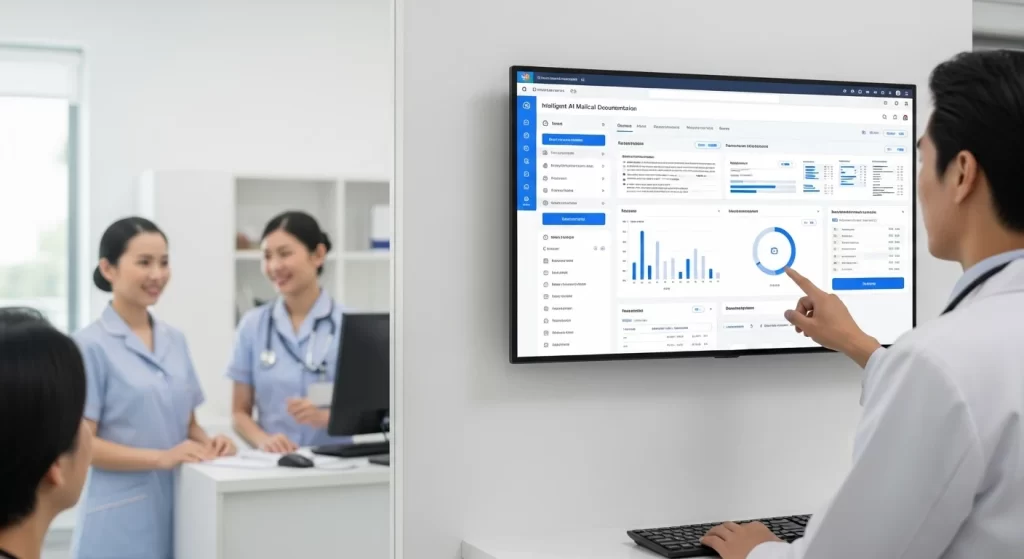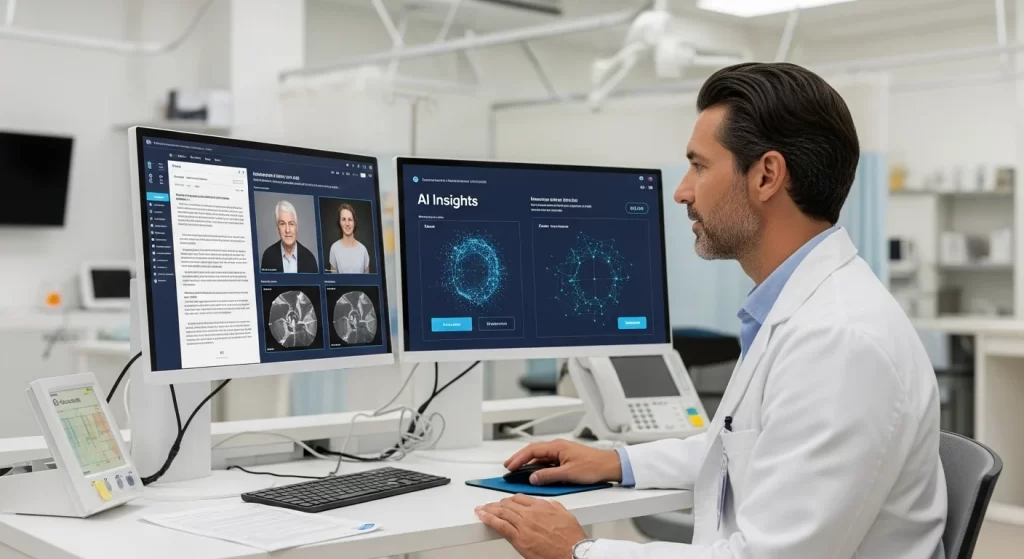The modern healthcare landscape faces a significant administrative burden, mainly due to the demands of medical documentation. This immense workload consumes valuable clinician time and contributes to widespread burnout among clinicians. The repetitive nature of data entry and the need to keep pace with evolving medical terminology and compliance requirements divert attention from direct patient care.

Beyond the sheer volume, traditional, manual documentation often results in fragmented, incomplete, or inaccurate patient records. These deficiencies obscure the full “patient story,” making it challenging to capture holistic insights, including crucial social determinants of health, patient preferences, and non-clinical contexts. Such compromises in data quality can lead to misdiagnosis, delayed treatments, and a lack of care continuity.
Intelligent AI medical documentation offers a transformative solution. AI for medical documentation alleviates the burden by automating tedious tasks, optimizing clinical workflows, and enabling clinicians to engage more meaningfully with patients. It enhances the quality, accuracy, and narrative depth of medical records, ensuring a more complete, actionable, and human-centered patient story. This blog post examines how AI medical documentation tools are reshaping the capture and utilization of healthcare information, transforming both efficiency and clinical insight.
Ready to transform your charting process and elevate your patient records? Explore how our intelligent AI medical documentation tools can address your burden!
The Administrative Chasm: Where Traditional Documentation Falls Short
This section outlines the specific challenges clinicians and healthcare systems encounter with conventional documentation, underscoring the critical need for innovative solutions like AI-powered medical documentation.

The Clinician’s Time Drain and Burnout
Medical documentation has become a primary consumer of clinician time, significantly impacting their ability to deliver patient-centered care.
Hours Spent on Charting
Healthcare professionals, including doctors and nurses, spend an average of 13.5 hours per week on clinical documentation, accounting for over a third of their working hours. That represents a 25% increase in documentation time over the last seven years. Consultant nurses report the highest documentation hours at 16.5 hours per week, followed by consultant doctors at 15.1 hours.
A concerning aspect is “pajama time”—documentation completed outside of regular working hours. Clinicians average 3.2 hours per week on documentation in their time, with consultant doctors averaging 4.7 hours. This after-hours charting significantly contributes to physician dissatisfaction and burnout.
The quantification of “pajama time” reveals a hidden opportunity cost, diverting time from personal well-being and contributing to emotional exhaustion and depersonalization. If AI can reclaim this time, the return on investment extends beyond financial metrics to preserving human capital and improving clinician quality of life. This positions AI adoption as a critical investment in clinician well-being, directly combating burnout and improving retention. Here is a summary of the clinician documentation burden:
| Metric | Statistic |
|---|---|
| Average Weekly Hours on Documentation (Overall) | 13.5 hours |
| Percentage of Average Working Hours on Documentation | > 33% |
| Increase in Documentation Time (last 7 years) | 25% |
| Consultant Nurses: Weekly Documentation Hours | 16.5 hours |
| Consultant Doctors: Weekly Documentation Hours | 15.1 hours |
| Average Weekly Hours on “Pajama Time” (Overall) | 3.2 hours |
| Consultant Doctors: Weekly “Pajama Time” | 4.7 hours |
| Physicians Reporting Excessive Documentation as Leading Burnout Cause | 62% |
Cognitive Overload and Distraction
The need for real-time manual documentation during patient encounters creates a significant cognitive burden and distraction. Studies show EHR use can lead to physicians maintaining less eye contact (79.1%), listening less carefully (53.5%), and focusing less on patients (65.1%), making visits feel less personal overall (62.8%). That is notable as patients often perceive EHR use positively, highlighting a perception gap.
The constant navigation of complex EHR interfaces, clicking through multiple screens, shatters a clinician’s focus, leading to cognitive overload. This mental fatigue can impair decision-making, reduce efficiency, and impede real-time communication and empathetic patient interaction. Clinicians are forced into a “doctoring while typing” workflow, worsening their professional satisfaction.
The observation that clinicians feel distracted and have less eye contact due to EHRs suggests an erosion of the clinician-patient relationship, which impacts the “human connection” and “empathy” that patients seek. AI-driven medical documentation with automated scribing can restore this crucial human element, allowing clinicians to maintain eye contact and focus on the patient’s narrative and nonverbal cues, thereby fostering deeper engagement and trust.
The Quality Deficit and Lost Narratives
The challenges of traditional documentation extend beyond time management, directly impacting the integrity and comprehensiveness of patient records.
Incomplete and Inaccurate Records
The pressures of manual documentation, combined with time constraints and inconsistent terminology, often result in fragmented, incomplete, or inaccurate medical records. These issues have severe consequences for patient safety and continuity of care.
A significant 20% of medical malpractice cases involve at least one documentation failure. Common errors that increase the odds of indemnity payment include alterations to records, insufficient documentation of clinical findings, rationale, and informed consent. Patient misidentification, often due to duplicate or wrong records, accounts for an alarming 70% of adverse patient outcomes. High duplication rates, sometimes as high as 30%, further complicate care and increase workload.
Clinicians report that in a quarter (25%) of instances, the needed information is unavailable at the right time, with incomplete information being the primary cause. This forces clinicians to spend more time searching for information, a task that has increased from 55 to 62 minutes per day.
The prevalence of incomplete and inaccurate records directly leads to patient safety issues. Lack of interoperability and data silos across healthcare systems exacerbate this issue, preventing a comprehensive view of patient data. When clinicians cannot access critical information in real time, initial documentation flaws propagate through the care continuum, increasing errors and adverse events. AI-driven medical documentation must prioritize seamless integration and data standardization to ensure a unified and accessible patient record.
Hindrances to Comprehensive Patient Storytelling
Electronic Health Records (EHRs), while beneficial, often fall short of capturing the whole, nuanced patient narrative. Their structured, template-driven nature can prevent the inclusion of critical non-clinical contexts, such as social determinants of health (SDoH), patient preferences, emotional narratives, and lived experiences.
Experts in narrative medicine emphasize that EHRs often “depersonalize care” by failing to capture “what matters to them” (patients) beyond merely “what’s the matter with them” (diseases). This oversimplification can render medicine less effective, especially in complex cases where social factors influence health outcomes. The lack of uniform data models for SDoH in EHRs further compounds this challenge.

Unstructured data, such as free-text notes, often contain these vital details; however, their unstandardized format makes them challenging to extract and analyze, leading to a “lost patient story.” The widespread practice of “copy and paste” within Electronic Health Records (EHRs) can also perpetuate outdated or incorrect data, hindering the capture of a comprehensive and accurate patient narrative.
The challenge of capturing comprehensive patient narratives is profoundly ethical. When EHRs fail to capture social determinants of health or patient preferences, it leads to the “depersonalization of care,” impacting treatment adherence and health equity. The “lost patient story” refers to instances where care plans may not align with a patient’s values or real-world circumstances. AI medical documentation, by leveraging advanced Natural Language Processing (NLP) to extract nuanced insights and integrate social determinants of health, can help build a truly holistic patient record that supports personalized, equitable, and human-centered care.
The Intelligent Edge: How AI Medical Documentation Tools Transform Data Capture
This section explains the core technological mechanisms behind AI medical documentation, detailing how these intelligent tools capture, interpret, and structure clinical information to create high-quality, comprehensive records.
From Voice to Structured Insight: Ambient AI and Natural Language Processing
The fundamental transformation brought by AI medical documentation begins with its ability to seamlessly capture and understand spoken language in clinical settings.
Real-time Scribing from Spoken Conversations
AI medical documentation tools utilize ambient listening technology to capture and transcribe natural conversations between patients and clinicians in real time. Unlike traditional dictation, ambient AI passively records the entire interaction through specialized microphones, allowing clinicians to maintain a natural flow of conversation without disruption.
Advancements in Automatic Speech Recognition (ASR) tailored for medical contexts are crucial. These systems are trained on millions of medical conversations and documents, enabling them to recognize complex medical terminology, understand clinical workflows, and interpret nuances of doctor-patient interactions. This specialized training allows AI to accurately distinguish between similar-sounding medical terms, understand abbreviations, and differentiate between symptom discussion and diagnosis determination. AI scribe technology has undergone significant improvements, with many systems now achieving over 95% transcription accuracy and some specialized models reaching an impressive 98.5% accuracy.
The power of unobtrusive data capture is evident in the design of ambient AI. Traditional documentation methods interrupt the patient-clinician flow. Ambient AI’s passive and real-time listening capabilities, combined with high ASR accuracy, enable data capture without interrupting patient interaction. This unobtrusiveness and accuracy free up clinician attention, fostering deeper patient engagement and trust.
Understanding Context with Advanced NLP and NLU
Beyond mere transcription, Natural Language Processing (NLP) and Natural Language Understanding (NLU) capabilities are fundamental to AI medical documentation. These technologies enable AI to interpret the meaning of clinical dialogue, extract key entities, and understand the broader context, transforming raw speech into structured, actionable insights.
NLU, a critical subset of NLP, focuses on understanding the intent and meaning behind text. It enables AI to move beyond simply recognizing words to interpreting the specific meaning of medical terms within a conversation, taking into account nuances in language and patient data. This deep comprehension is vital for accurate clinical documentation.
Key functionalities that enable this contextual understanding include:
- Named Entity Recognition (NER): Identifies and categorizes medical entities such as MEDICINE_NAME, DISORDER, SIGN_SYMPTOM, BODY_STRUCTURE, TEST_NAME, TREATMENT, PROCEDURE, and DOSAGE.
- Relation Extraction: Identifies semantic relationships between different entities, linking a MEDICINE_NAME to its DOSAGE or FREQUENCY.
- Assertion Detection: Determines the certainty (e.g., “certain,” “possible,” “negated”), temporality (e.g., “present,” “past”), and subject (e.g., “patient,” “physician”) of a medical entity.
- Entity Linking: Associates recognized entities with their corresponding nodes in a standardized knowledge base or ontology (e.g., linking “Acute hypoxia” to its ICD-10-CM code J96.01).
These advanced capabilities enable AI to semantically comprehend the entire conversation, filter out irrelevant content, and accurately identify medically relevant details, such as diagnoses, symptoms, and treatments. The semantic bridge from unstructured to structured data is a pivotal advancement. Healthcare data is complex, with a wealth of valuable information residing in unstructured text and spoken language. NLP/NLU’s ability to perform Named Entity Recognition, relation extraction, and assertion detection acts as a crucial semantic bridge, transforming human language into structured, analyzable data that can seamlessly populate EHR fields.
Weaving the Patient Story: Narrative Generation & Contextualization
The true power of AI medical documentation lies in its ability to synthesize extracted information into comprehensive, coherent patient narratives, moving beyond mere data points.
Automated Information Extraction and EHR Integration
Once AI medical documentation systems have accurately captured and interpreted the clinical conversation, they automatically extract relevant clinical data and populate structured fields within the Electronic Health Record (EHR). This automated process significantly minimizes manual data entry, a major source of time drain and errors.
AI systems are designed to map extracted entities—such as diagnoses, medications, procedures, and lab results—directly to the appropriate structured fields in major EHR systems, including Epic, Cerner, and Athenahealth, ensuring seamless integration. This automated data mapping ensures critical information is consistently and accurately recorded, enhancing data integrity and reducing the risk of missing or misfiled data.
Beyond simply populating data, generative AI can also draft, edit, and summarize various clinical documents, including bedside shift reports, discharge summaries, and patient histories. For example, HCA Healthcare partnered with Google Research to develop an AI tool to generate nurse handoff reports, identifying critical details and key events from patient interactions to create focused, actionable summaries.
Generating Cohesive Clinical Narratives
A pivotal capability of intelligent AI medical documentation is its ability to generate comprehensive, grammatically correct, and clinically relevant notes (e.g., SOAP notes, H&P, discharge summaries) from both extracted structured data and unstructured conversational context. This advanced function creates a truly coherent and informative patient story.
Generative AI models, particularly large language models (LLMs) like GPT-based architectures, are adept at this task. Trained on vast datasets of medical text, these models produce human-like responses and synthesize disparate information into cohesive, contextually relevant narratives.
Techniques such as abstractive summarization are key, allowing AI to create new, concise text based on its interpretation and trained knowledge base rather than just repeating extracted content. That ensures generated notes maintain a logical flow and accurately capture the essence of the patient encounter. While challenges exist with “hallucinations” (inaccurate information) and omissions, techniques like Retrieval-Augmented Generation (RAG) and robust human-in-the-loop review processes mitigate these risks, ensuring factual consistency and reliability.
The transition from AI merely “scribing” to actively “generating narratives” is profound. It implies AI is actively constructing a coherent story, synthesizing disparate information into readable, logical prose. That moves AI from a data entry tool to a powerful knowledge organization and communication enhancer, directly addressing the “lost patient story” dilemma by preserving the full context of a patient’s journey for better clinical reasoning and care coordination.
Automated Compliance and Error Prevention
Beyond documentation generation, AI plays a crucial role in enhancing the accuracy and compliance of medical records, acting as a proactive guardian of data integrity.

Leveraging Historical Patient Data for Context
Intelligent AI medical documentation systems pull relevant historical patient data from the EHR to provide crucial context for the current encounter. This contextual awareness informs note-taking, seamlessly integrating past medical history, previous diagnoses, medications, and lab results into the current clinical note.
By cross-referencing new information with historical data, AI can proactively flag discrepancies or inconsistencies, prompting clinicians to review them. This anticipatory approach ensures that documentation is accurate for the immediate visit and consistent with the patient’s longitudinal health record, thereby improving care continuity and reducing errors that result from an incomplete understanding of the patient’s history.
Flagging Anomalies and Potential Risks
AI for medical documentation identifies inconsistencies, potential coding errors, and subtle risk factors within documented information, prompting clinicians to review and ensure higher accuracy.
AI algorithms detect and correct inconsistencies in clinical data in real-time, such as misentered lab values or duplicate records. They can flag dangerously high medication dosages, incorrect patient names, or lab results outside expected ranges, significantly reducing human error.
Furthermore, AI identifies patterns that deviate from compliant practices, such as potential coding violations or missing documentation elements required by regulatory standards. This real-time feedback enables practitioners to correct errors promptly, thereby enhancing overall documentation quality and ensuring compliance.
The ability of AI to leverage historical data for context and flag anomalies in real-time shifts error detection from a reactive to a proactive approach. That transforms documentation from mere record-keeping into an active safety net and quality assurance mechanism. By embedding real-time checks and contextual intelligence, AI medical documentation becomes an integral part of patient safety protocols, reducing adverse events and improving overall care quality.
Unleashing Value: The Multifaceted Impact of Advanced Documentation AI
This section quantifies and details the profound positive impacts of intelligent AI medical documentation across various dimensions, including clinician well-being, operational efficiency, and data integrity.
| Benefit Category | Specific Impact | Quantified Data (where available) |
|---|---|---|
| Clinician Well-being & Efficiency | Time Savings (daily) | 3.2 hours/day (physicians) |
| Time Savings (after-hours) | 30% reduction | |
| Time Savings (annual) | 15,791 hours (1,794 workdays) | |
| Documentation Stress Reduction | 61% reduction | |
| Work-Life Balance Improvement | 54% improvement | |
| Job Satisfaction Increase | 47% increase | |
| Burnout Symptoms Decrease | 38% decrease | |
| Improved Overall Work Satisfaction | 82% (Permanente Medical Group) | |
| Data Quality & Patient Care | Documentation Accuracy | >98% through algorithmic checks |
| Error Rate Reduction (speech-to-text vs. typing) | 20% lower error rate | |
| AI Scribe Accuracy Claims | 95-98% | |
| Clinical Validation Issues Caught | 32% more than traditional | |
| SDoH Identification Rate | 93.8% (vs. 2% via codes) | |
| Financial & Operational | Claim Denial Rate Reduction | 30-50% |
| Claim Denial Rate Reduction (case study) | 15% to 2% (within 6 months) | |
| Claim Processing Speed | Up to 80% faster | |
| Revenue Recovery (case study) | $5 million | |
| Coding Turnaround Time Reduction | 48 hours to 12 hours | |
| Cash Flow Acceleration | 30% |
Empowering Clinicians: Time, Focus, and Well-being
The adoption of AI medical documentation tools offers substantial benefits to clinicians, directly addressing the pervasive issues of time scarcity and burnout.
Significant Time Savings and Reduced Administrative Burden
One of the most immediate and impactful benefits of AI medical documentation tools is the dramatic reduction in documentation time, directly freeing up clinicians for more direct patient care. Research consistently quantifies these significant savings:
- Physicians using AI scribes have reported saving an average of 3.2 hours per day on documentation tasks.
- Other studies show clinicians spending 20% less time on EHRs, with a 30% reduction in after-hours work. That translates to two additional minutes of face-to-face patient interaction per visit and 15 extra minutes of personal time daily.
- Large-scale implementations demonstrate substantial aggregate savings: The Permanente Medical Group’s ambient AI scribes saved physicians an estimated 15,791 hours of documentation time in one year, equivalent to 1,794 eight-hour workdays.
- Some systems claim even more aggressive reductions of 50-75% in documentation time.
These quantifiable time savings directly reduce the administrative burden, allowing clinicians to complete notes on the same day and significantly decrease “pajama time,” the hours spent charting after regular work hours.
Combating Burnout and Improving Focus
The reduction in administrative tasks directly contributes to lower clinician burnout rates, improved job satisfaction, and a renewed focus on empathetic patient interaction. Excessive documentation requirements are consistently identified as a leading cause of physician burnout. Qualitative and quantitative feedback from clinicians highlights this profound positive impact:
- A 2024 study of 1,250 physicians found that those using AI scribes reported a 61% reduction in documentation-related stress, a 54% improvement in work-life balance, a 47% increase in job satisfaction, and a 38% decrease in burnout symptoms.
- Pilot programs have shown remarkable results, with Mass General Brigham reporting a 40% relative reduction in burnout.
- MultiCare clinicians reported a 63% reduction in burnout and a 64% improvement in work-life balance.
- An overwhelming 82% of Permanente Medical Group physicians using AI scribes reported improved overall work satisfaction.
By automating documentation, AI frees up clinicians’ mental energy for complex clinical reasoning, allowing them to maintain eye contact and listen actively to the patient’s story and nonverbal cues, thereby restoring the fundamental human connection in medicine.
The clinician burnout crisis incurs significant human and financial costs, resulting in increased medical errors, diminished quality of care, and high turnover rates. The quantifiable reductions in burnout and improvements in job satisfaction demonstrate that AI is not merely a tool for efficiency but a strategic imperative for preserving human capital in healthcare. Investing in AI medical documentation is a long-term strategy for workforce sustainability and resilience, fostering a more humane and effective work environment.
Elevating Data Integrity and Actionable Insights
The impact of AI medical documentation extends critically to the quality and comprehensiveness of patient records, transforming them into more reliable and insightful resources.

Improved Accuracy and Consistency
AI-driven medical documentation tools consistently lead to more accurate, consistent, and standardized clinical notes compared to manual methods, significantly reducing errors and enhancing overall data integrity.
- AI-powered tools can achieve accuracy levels above 98% through sophisticated algorithmic checks.
- Speech-to-text tools on mobile devices have been shown to have a 20% lower error rate than traditional typing.
- Vendors consistently claim high accuracy rates of 95-98% for AI scribes.
- AI systems can identify and flag up to 32% more clinical validation issues than traditional documentation processes.
- AI ensures consistency through the application of templates and standardized terminology, converting abbreviations or layperson’s terms into standard medical vocabulary, thereby significantly improving clarity and communication across the care team.
By automating data validation and cleaning, AI can identify missing values, detect duplicate patient records, and correct misformatted data entries in real time, proactively preventing downstream errors that might otherwise compromise care.
Richer, More Comprehensive Patient Records
Intelligent AI medical documentation enables the capture of a more comprehensive patient narrative, including crucial social determinants of health (SDoH), patient-reported outcomes, and the subtle nuances of the clinical interaction that are often missed in traditional charting.
Generative AI models can be trained to automatically extract information on SDoH from clinicians’ notes, which are frequently under-documented in EHRs. One study found that finely tuned AI models could identify 93.8% of patients with adverse social determinants of health (SDoH), whereas official diagnostic codes included this information in only 2% of cases. This capability significantly enhances data completeness regarding social factors, including employment, housing, transportation, and social support.
AI can go beyond simple transcription to “truly listen” during patient encounters, flagging statements that reveal key patient values and preferences. This enables the capture of nuanced emotional narratives and non-clinical contexts, which are crucial for personalized care and aligning treatment with a patient’s life goals.
By transforming unstructured conversational data into structured, analyzable information, AI creates richer, more comprehensive patient records that encompass the full “tapestry” of a patient’s life and values, not just their clinical symptoms.
The ability of AI to extract SDoH with high accuracy and identify patient values effectively “unlocks” valuable patient information often existing as “dark data” within unstructured notes. This transformation is crucial for advancing towards precision medicine and population health management. AI medical documentation is not just improving existing data; it is creating entirely new data points and insights that were previously unattainable or too labor-intensive to capture. This richer dataset supports more informed clinical decisions, proactive interventions, and equitable care delivery.
Financial and Operational Optimization
The benefits of AI medical documentation extend significantly to the financial health and operational efficiency of healthcare organizations.
Automated Compliance Checks and Auditing
AI medical documentation significantly automates checks for regulatory compliance (e.g., CPT coding and billing requirements) and streamlines both internal and external audits.
- AI continuously audits coding practices by comparing submitted codes against current regulatory guidelines and payer rules.
- It automatically flags potential compliance risks or discrepancies, enabling coding teams to address issues and stay aligned with regulations quickly.
- AI-driven systems can instantly verify provider credentials, preventing unintentional lapses that could lead to financial penalties or reputational damage.
- This proactive approach reduces audit risk and protects healthcare providers from costly fines and legal exposure.
- AI can quickly generate comprehensive reports on past compliance performance, highlighting areas of potential risk and providing the precise data auditors require, saving countless hours of manual preparation.
Accelerated Reimbursement Cycles
More accurate, complete, and compliant medical notes generated by AI for medical documentation directly lead to faster claims processing, fewer denials, and optimized reimbursement for healthcare organizations.
- AI-driven claims management solutions can reduce claim denials by 30-50%, resulting in a significant revenue recovery.
- Hospitals have reported a dramatic reduction in denial rates, from 15% to as low as 2%, within six months of implementing AI-driven coding platforms.
- AI accelerates claims processing by automatically filling in accurate details and prioritizing high-value claims, resulting in up to 80% faster claim processing times compared to manual workflows.
- It automates follow-ups and appeals, thereby reducing payment delays, and can even optimize collection processes by creating personalized patient payment plans based on individual financial situations.
- One hospital system successfully recovered $5 million in previously denied claims by addressing documentation gaps and coding inaccuracies with AI.
- AI can significantly improve inpatient coding, reducing the average coding turnaround time from 48 hours to just 12 hours, which in turn accelerates cash flow by 30%.
The financial health of healthcare organizations is directly tied to accurate and compliant documentation, as well as efficient revenue cycle management. Manual processes are prone to errors and delays, resulting in significant lost revenue due to denied claims. AI’s ability to automate compliance checks and proactively prevent denials positions it as a vital “revenue integrity guardian.” It optimizes and protects financial flow, ensuring appropriate reimbursement and allowing for crucial reinvestment in patient care and innovation.
Strategic Implementation: Navigating Adoption of AI Medical Documentation with SPsoft
Successfully navigating the complexities of AI implementation requires a strategic partner with deep expertise and a collaborative approach. SPsoft offers tailored solutions designed to meet the unique needs of healthcare organizations.

Custom AI Medical Documentation Solution Development
Adequate AI medical documentation often requires a tailored approach, recognizing that diverse medical specialties, unique documentation styles, and specific organizational requirements necessitate bespoke solutions. SPsoft excels in developing custom AI models and platforms precisely optimized for distinct needs.
A custom approach allows for:
- Specialty-Specific Nuances: Training AI models on datasets highly relevant to particular medical fields (e.g., oncology, cardiology, mental health) to ensure exceptionally high accuracy in specialized terminology and workflows.
- Workflow Alignment: Designing AI tools that seamlessly integrate into existing clinical workflows, minimizing disruption and maximizing user adoption.
- Scalability and Flexibility: Building solutions with inherent scalability to effortlessly grow with the organization’s needs, adapting to increasing documentation volumes and evolving practices.
SPsoft’s expertise in custom AI development ensures the solution is a precisely engineered tool addressing unique challenges and opportunities specific to each client’s environment.
End-to-End Secure, Compliant, and Scalable Deployment
SPsoft provides a comprehensive process from initial strategy and design through secure development, rigorous testing, and compliant deployment of AI medical documentation tools. Security and compliance are meticulously embedded at every stage.
This end-to-end commitment includes:
- Robust Security Protocols: Implementing advanced encryption techniques (e.g., AES-256), multi-layer security architectures, and secure cloud storage solutions to protect sensitive patient data.
- Regulatory Compliance Expertise: Ensuring strict adherence to HIPAA, GDPR, PIPEDA, and other relevant data protection standards, including legally sound Business Associate Agreements.
- Scalable Architecture Design: Building solutions with inherent scalability to handle growing documentation volumes, diverse language requirements, and multi-company coverage.
- Responsible AI Frameworks: Adhering to principles of fairness, appropriateness, validity, effectiveness, and safety in AI deployment, ensuring ethical and trustworthy operation.
Seamless Integration and Workflow Optimization
SPsoft ensures AI medical documentation tools integrate smoothly into existing IT infrastructure and clinical workflows without disruption. That is achieved through a deep understanding of the client’s current systems and operational processes.
SPsoft’s services in this area include:
- Technical Integration Capabilities: Utilizing standardized APIs (e.g., FHIR, HL7), middleware, and custom connectors for seamless data exchange with diverse EHRs and legacy systems.
- Workflow Analysis and Optimization: Conducting thorough needs assessments to map existing workflows, identify bottlenecks, and define precise automation goals, ensuring the AI solution enhances daily clinical practice.
- User Experience (UX) Focus: Designing intuitive interfaces that minimize the learning curve and maximize user satisfaction, ensuring clinicians find the tools easy to use and beneficial.
Collaborative Partnership and Post-Implementation Support
SPsoft operates on a collaborative partnership model, engaging deeply with clinicians and IT teams throughout the entire implementation process. This collaborative approach is essential for ensuring successful user adoption and promoting continuous improvement.
SPsoft’s commitment extends beyond initial deployment to include:
- Comprehensive Training Programs: Providing healthcare professionals with the necessary training to use AI-based documentation tools effectively.
- Pilot Programs and Phased Implementation: Conducting pilot programs and phased rollouts for iterative refinement and smooth integration.
- Continuous Optimization: Actively gathering user feedback to continuously refine AI models and ensure ongoing relevance and optimal performance.
- Long-Term Partnership: Offering ongoing support, maintenance, and updates to adapt to evolving clinical needs, regulatory changes, and technological advancements.
The success of AI in healthcare depends on user acceptance and clinician satisfaction. SPsoft’s emphasis on collaborative partnerships, user experience, and training addresses this human element, which is vital for effective change management. The actual value is realized not just through tech capabilities, but also through successful integration into human workflows and acceptance by end-users.
Conclusion: The End of the Burden, The Rise of Insight
Intelligent AI medical documentation is fundamentally transforming healthcare, moving far beyond merely easing administrative burdens. It elevates data quality and preserves the comprehensive patient story, directly addressing long-standing challenges that have plagued clinicians and, in turn, compromised patient care.

By automating the tedious, time-consuming aspects of charting, AI frees up invaluable time and cognitive capacity, enabling clinicians to refocus on the humanistic core of medicine. This profound shift ensures that medical records are not just static repositories of facts but dynamic, holistic narratives that capture the full spectrum of a patient’s health journey, including crucial social and personal contexts.
The profound impact of AI medical documentation extends across multiple facets of healthcare. It significantly improves clinician well-being and reduces burnout, fostering greater job satisfaction and a renewed sense of purpose within the profession. Enhanced data accuracy and consistency lead directly to improved patient safety, mitigating medical errors and reducing instances of misidentification. Operationally, AI streamlines compliance checks, accelerates reimbursement cycles, and optimizes financial performance, allowing healthcare organizations to thrive in an increasingly complex environment. Ultimately, AI unlocks richer, actionable insights from clinical data, paving the way for more precise diagnoses, truly personalized treatment plans, and proactive interventions that anticipate patient needs.
Stop drowning in paperwork and start focusing on what truly matters: your patients. Let SPsoft’s expertise in AI for medical documentation reshape your record-keeping!
FAQ
How much time do doctors spend on paperwork?
A lot. On average, healthcare professionals spend 13.5 hours per week on clinical documentation—that’s over a third of their working hours. This often spills into personal time, with clinicians averaging 3.2 hours of “pajama time” charting at home each week. It’s no surprise that 62% of physicians point to excessive documentation as a leading cause of burnout.
Can an AI listen to my doctor’s visit and write the note?
Yes, that’s the power of ambient AI. This technology utilizes specialized microphones to passively listen to and transcribe the natural conversation between you and your clinician in real-time. Unlike old-school dictation, it doesn’t interrupt the visit. With accuracy rates now exceeding 95%, it enables your doctor to focus entirely on you, rather than typing, thereby restoring the human connection in medicine.
How does AI understand the difference between medical terms?
Beyond just transcribing words, AI uses Natural Language Processing (NLP) and Natural Language Understanding (NLU). These advanced technologies interpret the meaning and context of the clinical dialogue. NLP can identify specific medical entities (like medications, symptoms, and dosages), understand their relationships, and even determine if a symptom is current or from the past, ensuring the final note is clinically accurate.
My medical records seem messy. Can AI fix them?
AI is a powerful tool for improving data quality. It can automatically detect and flag inconsistencies, duplicate records, or misentered lab values in real-time. Cross-referencing new information with your historical data ensures consistency across your entire health record. This proactive approach helps prevent the kinds of documentation failures that are found in 20% of medical malpractice cases.
What is the “patient story,” and why does it get lost?
The “patient story” includes crucial context beyond your diagnosis, like your life circumstances, personal preferences, and emotional state—the things that make you unique. Traditional EHR templates often fail to capture this narrative, focusing only on the disease. AI helps recover this “lost story” by analyzing conversations to flag patient values and social determinants of health (SDoH), creating a more holistic and human-centered record.
Can AI help reduce doctor burnout?
Yes, significantly. By automating the tedious documentation process, AI directly tackles a primary driver of burnout. A recent study found that physicians using AI scribes reported a 61% reduction in documentation-related stress, a 54% improvement in work-life balance, and a 38% decrease in burnout symptoms. This allows them to reclaim their time and focus on the more rewarding aspects of patient care.
Does AI find essential health factors that are usually missed?
Absolutely. Key factors, such as housing, employment, and social support—known as Social Determinants of Health (SDoH)—are vital for health outcomes but are rarely documented using official codes. One study found that AI models could identify 93.8% of patients with adverse SDoH from doctors’ notes. In contrast, diagnostic codes captured this information in only 2% of cases, revealing critical insights for care.
Does better AI documentation save the hospital money?
Yes, the financial impact is substantial. More accurate and complete documentation leads to fewer claim denials and faster reimbursement. AI-driven solutions can reduce claim denials by 30-50% and accelerate claims processing by up to 80%. One hospital system was able to recover $5 million in previously denied claims by using AI to address documentation gaps and coding inaccuracies.
How does the AI generate a final, readable note?
AI utilizes a technology called generative AI, often powered by large language models (LLMs). After extracting key data points from the conversation, these models synthesize the information into a cohesive, grammatically correct clinical narrative, like a SOAP note. They employ techniques such as abstractive summarization to create new, concise text, rather than simply copying and pasting, ensuring the final note tells a clear and logical story.
Is an off-the-shelf AI solution good enough for any medical practice?
Not always. Different medical specialties have unique terminology and workflow needs. A “one-size-fits-all” product may not be the optimal solution. A custom AI medical documentation solution, like those developed by SPsoft, can be trained on specialty-specific data. This tailored approach ensures higher accuracy and seamless integration into existing clinical workflows, maximizing the benefits for both clinicians and patients.



